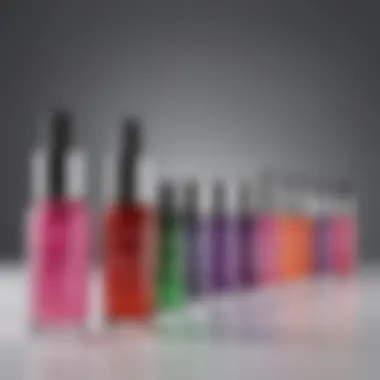Unlocking the Secrets of Dermalinfusion Facials


Intro
In the realm of skincare, innovation is a constant. Among the myriad treatments available, few stand out as significantly as dermalinfusion facials. This unique method effectively combines exfoliation, extraction, and infusion of tailored serums to rejuvenate the skin. The approach, grounded in science, addresses various skin concerns from dullness to excessive oil, offering immediate and long-lasting results.
Understanding the mechanism of dermalinfusion facials is key for both practitioners and clients. This article explores the underlying processes, benefits, and aftercare associated with the treatment. Furthermore, it provides insight into product selection and expert advice, ensuring clarity for beauty enthusiasts and professionals alike.
By delving deep into specifics, we aim to equip readers with valuable knowledge that enhances their experience with dermalinfusion facials. Ultimately, the goal is to empower individuals to make informed choices about their skincare journey.
Understanding Dermalinfusion
Understanding dermalinfusion is crucial for anyone interested in contemporary skincare innovations. This treatment melds exfoliation, extraction, and infusion, promising a multidimensional approach to achieving healthy skin. Grasping the nuances of dermalinfusion not only allows beauty enthusiasts to appreciate its benefits but also opens avenues for informed decisions regarding product selection and maintenance routines.
Definition and Overview
Dermalinfusion is a specialized skincare treatment that utilizes a unique device to deliver a three-in-one mechanism: exfoliation, extraction, and the infusion of customized serums. The customizable serums include active ingredients tailored to address individual skin concerns. Common issues targeted by dermalinfusion treatments are dehydration, aging signs, and uneven texture. By employing a non-invasive approach, dermalinfusion stands out in the realm of facial treatments, providing immediate results with minimal downtime.
Historical Context
The concept of skin rejuvenation dates back centuries, evolving with advancements in cosmetic science. Dermalinfusion technology originated within the field of dermatology, gaining traction in professional skincare circles about two decades ago. Initially, microdermabrasion was a popular technique for exfoliation, but dermalinfusion introduced a more synergistic approach. By integrating the exfoliation process with serum infusion at the same time, it marked a significant leap in skincare treatments, leading to its widespread acceptance within beauty clinics and spas.
Mechanism of Action
The mechanics behind dermalinfusion are both straightforward and effective. During the treatment, the device's diamond-tipped wand glides across the skin, gently exfoliating the outer layer and removing dead skin cells. Simultaneously, a vacuum mechanism extracts impurities from the pores. Most importantly, as the skin is exfoliated, serums are infused deep into the dermal layer. This dual action enhances the skin's ability to absorb vital nutrients, effectively improving skin health. Understanding this mechanism emphasizes why dermalinfusion is often favored for its efficiency and long-lasting results.
Benefits of Dermalinfusion Facials
Dermalinfusion facials present a multifaceted approach to skincare that can address various skin concerns. The integration of exfoliation, extraction, and serum infusion serves as a comprehensive remedy for a range of skin types and conditions. Understanding the benefits of this treatment can help both skincare enthusiasts and industry professionals appreciate its significance in modern skincare regimens.
Immediate Effects
The immediate effects of dermalinfusion facials are often noticeable right after the procedure. The skin usually appears brighter and more radiant. This prompt enhancement is due to several factors:
- Exfoliation removes dead skin cells, leading to a smoother texture.
- Extraction eliminates debris and impurities from pores, reducing the chances of breakouts.
- The infused serums, rich in vitamins and hydrating agents, deliver a surge of nutrients, improving skin hydration and vitality instantly.
Patients often report that their skin feels softer and looks more even-toned. Many professionals observe that clients frequently comment on the immediate glow that results from this treatment. This experience can significantly boost self-esteem, as individuals feel more confident in their skin right after the session.
Long-Term Results
While the immediate results are appealing, the long-term benefits are where dermalinfusion facials truly shine. Regular sessions can lead to improvements in several areas:
- Collagen Production: Improved collagen synthesis is often reported, leading to enhanced skin elasticity and firmness.
- Reduction in Fine Lines: Continued treatments can visibly diminish the appearance of wrinkles and fine lines, contributing to a more youthful appearance.
- Even Skin Tone: Over time, many clients notice a reduction in hyperpigmentation and overall improvement in skin tone and texture.
Moreover, as the skin continues to absorb beneficial ingredients from the serums, it may become less susceptible to environmental damage. Consequently, the cumulative effects of these facials can lead to a significant transformation in skin health and appearance over months of regular treatments.
Comparative Advantages
When comparing dermalinfusion facials to other skincare treatments, the unique advantages become apparent. They stand out for several reasons:
- Non-invasiveness: Unlike surgical procedures or intensive treatments, dermalinfusion facials offer a non-invasive solution with minimal downtime.
- Customizability: The ability to tailor serum infusions to individual skin types and concerns is an advantage that many other treatments lack.
- Multi-tasking: The combination of exfoliation, extraction, and infusion in one session enhances overall effectiveness, making it a time-efficient option for busy clients.


According to several dermatologists, this treatment effectively combines the benefits of various techniques into one streamlined process. Dermalinfusion facials thus provide an efficient alternative for clients seeking comprehensive skin care solutions without multiple appointments.
"Dermalinfusion offers immediate satisfaction paired with long-lasting results, creating a remarkable synergy that sets it apart in the beauty industry." - Skincare Specialist
The Procedure
The procedure of dermalinfusion facials is a crucial element in understanding how this treatment works and why it is gaining popularity. It involves a series of steps that aim to achieve optimal skin health through exfoliation, extraction, and the infusion of skin-enhancing serums. Understanding this comprehensive process can help individuals appreciate not only the immediate results but also the long-term benefits that come from proper execution.
Pre-Treatment Preparation
Before undergoing a dermalinfusion facial, adequate preparation is essential. This initial stage significantly impacts the treatment's efficacy. The skin must be free of makeup and impurities; therefore, cleansing is the first step. Professionals typically use a gentle foaming cleanser to remove dirt and oils without disrupting the skin's barrier. Following this, a thorough assessment of the skin type and condition is necessary. Clients should communicate any skin issues or concerns to their esthetician. This dialogue enables the selection of suitable serums tailored to the client's needs, maximizing the benefits.
Step-by-Step Process
Once the skin is prepared, the step-by-step process can begin. The dermalinfusion device, which combines exfoliation and infusion capabilities, will be employed. Here is a breakdown of the procedure:
- Exfoliation: A vacuum-powered device gently removes dead skin cells. This step is vital as it paves the way for better serum penetration.
- Extraction: The device helps extract impurities from pores, reducing blackheads and whiteheads effectively.
- Serum Infusion: With the skin now prepared, targeted serums are infused deeply into the skin. Each serum is designed to treat specific skin concerns, such as hydration or pigmentation issues, ensuring maximum efficacy.
- Aftercare Guidance: Following the procedure, estheticians provide recommendations for skincare routines to maintain results.
Post-Treatment Care
Post-treatment care is a paramount factor that can influence the durability of the results achieved from the dermalinfusion facial. The skin may be sensitive immediately following the treatment, making it vital to adhere to aftercare instructions. Important considerations include:
- Avoid Direct Sunlight: It is recommended to stay out of direct sunlight for at least 48 hours following treatment to minimize the risk of irritation.
- Use Gentle Products: Opt for mild, non-irritating skincare products for a few days. Avoid exfoliants and strong actives that may aggravate the skin.
- Hydration: Keeping the skin hydrated is critical. Clients should apply a recommended moisturizer regularly to maintain moisture levels and promote healing.
- Follow-up Treatments: Regular follow-ups can be beneficial for sustained results. Typically, clients are advised to return for additional treatments every four to six weeks.
By adhering to these post-treatment care instructions, individuals can maximize the benefits of their dermalinfusion facial, ensuring that their skin remains radiant and healthy.
Potential Risks and Considerations
In any skincare treatment, awareness of potential risks and considerations is essential. Dermalinfusion facials, being a combination of exfoliation, extraction, and infusion, come with their own set of concerns. Understanding these risks aids clients in making informed decisions. Skincare professionals must also recognize these points to guide clients effectively, ensuring that expectations align with reality. This section covers common side effects and profiles those who might need to avoid the treatment altogether.
Common Side Effects
Although dermalinfusion facials are generally considered safe, clients may experience common side effects. These effects typically arise from the procedure itself and the active ingredients in the serums used. Patients should anticipate redness, mild swelling, or tenderness in the treated area. These symptoms are usually temporary and may last from a few hours to a couple of days. Here are several common side effects associated with dermalinfusion facials:
- Redness: This is the most typical reaction, appearing immediately post-treatment. It often resembles a mild sunburn.
- Swelling: Light swelling in the treated area can occur, largely due to the vacuum suction of the device used.
- Dryness or Flaking: Skin might feel dry for a brief period as the exfoliation process stimulates rejuvenation.
- Sensitivity: The skin may become more sensitive to certain products right after the treatment.
Most side effects clear up quickly, but it is advisable to seek advice from a professional if symptoms continue or worsen. Effective communication between practitioners and clients can help manage expectations and address any discomfort that arises.
Who Should Avoid This Treatment
While dermalinfusion facials offer many benefits, certain individuals might not be ideal candidates for this procedure. Specific skin conditions or underlying health issues can lead to negative outcomes or exacerbate existing problems. Here is a list of groups who should consider avoiding dermalinfusion facials:
- Individuals with Active Skin Conditions: Conditions such as eczema, rosacea, or active acne outbreaks should disqualify candidates from this treatment. It can worsen these issues due to skin sensitivity.
- People with Allergies: Those who have known allergies to specific active ingredients in serums should skip the treatment to prevent any adverse reactions.
- Pregnant or Breastfeeding Individuals: Caution is advised as certain ingredients may not be suitable during pregnancy or lactation.
- Sensitivity to Light: Those taking medication that heightens sensitivity to light should think carefully before proceeding, as some post-treatment care involves sun exposure.
It is essential for both clients and practitioners to be aware of these considerations. An open discussion about individual circumstances can enhance safety and ensure satisfaction with the results of the treatment.
Choosing the Right Products for Dermalinfusion
Choosing appropriate products for dermalinfusion is crucial for achieving optimal skincare results. The efficacy of the treatment largely depends on the serums used during the procedure. Each serum should be selected based on the individual's skin type and specific concerns. Therefore, understanding the components of these products is essential.
When selecting serums for dermalinfusion, one must consider key elements such as ingredient concentration, compatibility with skin types, and specific skin issues. Effective serums often contain a blend of hyaluronic acid, vitamins, antioxidants, and peptides. Each of these components plays a particular role in skin health and rejuvenation.


Moreover, the right products can enhance hydration, minimize wrinkles, and promote an even skin tone. Notably, targeting skin concerns like acne or hyperpigmentation requires different formulations. Thus, informed selection ensures that the treatment addresses the user’s unique skin challenges.
Components of Effective Serums
Effective serums must contain a potpourri of beneficial ingredients. Essential components include:
- Hyaluronic Acid: Known for its superior ability to retain moisture, making skin look plumper and more youthful.
- Vitamins (C and E): These antioxidants protect the skin from free radicals and enhance skin tone.
- Peptides: They stimulate collagen production, which is critical for skin elasticity.
- Botanical Extracts: Ingredients like green tea or chamomile calm inflammation and add extra nutrients.
Each ingredient serves its purpose, but their synergistic effects can amplify the benefits. Therefore, selecting serums that balance these components is paramount.
Dermatologist Recommendations
Consulting a dermatologist before undergoing dermalinfusion can be invaluable. Experts often recommend products that align with individual skin needs while ensuring safety and efficacy. Many dermatologists suggest that patients look for clinically proven products backed by research.
Also, a dermatologist may provide insight into formulations based on skin type:
- For Oily Skin: Lightweight, oil-free serums with salicylic acid can help control excess oil production.
- For Dry Skin: Rich, hydrating serums with glycerin are often preferred.
- For Sensitive Skin: Choosing hypoallergenic and fragrance-free options can prevent irritation.
By following expert recommendations, individuals can maximize the benefits of dermalinfusion, ensuring that the products used enhance rather than hinder results.
"The success of dermalinfusions derives not just from the technique but equally from the quality of serums employed."
Aftercare and Maintenance
Aftercare and maintenance are critical components following a dermalinfusion facial. Proper aftercare ensures that the skin remains healthy, maximizing the results of the treatment. It addresses concerns like irritation or dryness, which can occur post-treatment. Adhering to a structured aftercare routine not only aids in recovery but also enhances the longevity of the treatment's effects.
Daily Skincare Routine Post-Treatment
After receiving a dermalinfusion facial, it is essential to adopt a careful skincare routine. This routine aids the healing process and should prioritize gentle and hydrating products. Here are some essential components of a post-treatment skincare regimen:
- Gentle Cleansing: Use a mild, sulfate-free cleanser to avoid stripping the skin of its natural oils.
- Hydration: A hydrating serum or moisturizer should be applied regularly. Look for products containing hyaluronic acid or glycerin, as they attract and retain moisture.
- Sunscreen Application: Protecting the skin from UV rays is crucial. Use a broad-spectrum sunscreen with at least SPF 30. Reapply throughout the day, especially if exposed to sunlight.
- Avoid Active Ingredients: In the days following the treatment, refrain from using retinoids, alpha hydroxy acids, or other harsh ingredients that can irritate the skin.
- Listen to Your Skin: Pay attention to how your skin reacts. If you notice excessive redness or irritation, consult with a dermatologist before continuing your routine.
Frequency of Treatments
Determining the frequency of dermalinfusion facials is vital for achieving desired outcomes. Typically, treatments can be performed every four to six weeks, but individual skin types and concerns can affect this timetable. Consider the following points:
- Skin Condition: For individuals with significant skin issues, such as acne or hyperpigmentation, more frequent treatments may be beneficial initially, under the guidance of a professional.
- Long-term Maintenance: Once the desired results are achieved, spacing treatments further apart can help maintain skin health. Regular maintenance promotes ongoing hydration and skin rejuvenation, ensuring long-lasting results.
- Professional Evaluation: Consulting with a skincare specialist can provide tailored advice based on skin type and condition. They can recommend an optimal treatment plan suited to individual needs.
"Skin is a reflection of your lifestyle. Proper aftercare enhances your treatment and promotes lasting benefits."
Personal Testimonials and Case Studies
Personal testimonials and case studies play a pivotal role in the understanding of dermalinfusion facials. They provide real-life examples that showcase the effectiveness of the treatment, allowing potential clients to connect with the experiences of others. This section aims to emphasize the importance of these narratives by discussing their elements, benefits, and what considerations one should keep in mind when assessing them.
Personal testimonials can illustrate individual experiences, showing varying results based on skin types, concerns, and even the specific serums used during the treatment. They serve not only as motivation but also as a source of education. Potential clients look for relatable stories which can help them gauge their own expectations related to the treatment. Whether it is significant acne improvement, a reduction in pigmentation, or enhanced hydration, personal stories are a direct reflection of what dermalinfusion facials can achieve.
When discussing case studies, it is crucial to provide comprehensive details about the treatment protocols and product choices involved. For instance, examining a case study of someone with oily skin may involve highlighting how specific serums infused during the facials led to better oil control. These details enhance credibility and foster trust between clients and service providers.
However, while testimonials and case studies are beneficial, they must be analyzed critically. Individual satisfaction varies due to factors such as skin types, lifestyle choices, and genetic predispositions. Therefore, it is important for readers to approach these accounts with a balanced perspective, recognizing that results are not universally applicable.


Before and After Experiences
Before and after experiences provide a visual testament to the efficacy of dermalinfusion facials. They allow individuals to see firsthand the transformative effects these treatments can have on specific skin conditions. Many clinics encourage clients to document their journeys with photos taken prior to the treatment and after a series of sessions.
This contrast showcases improvements that can range from clearer textures to noticeable brightness in the skin tone. Photographic evidence often enhances motivation for those considering a treatment. It serves as a benchmark for potential results and assists in setting realistic expectations. However, while visual documentation offers insight, one must also regard the influence of external factors such as diet, environment, and skincare routines.
Furthermore, sharing these experiences can build a community where individuals support each other on their skin-care journeys, offering tips and sharing products that worked well alongside their treatments.
Expert Insights
Expert insights bring depth to the conversation surrounding dermalinfusion facials. Industry professionals, including dermatologists and licensed aestheticians, provide valuable input based on their expertise and clinical observations. Their insights often cover various topics such as treatment effectiveness, the ideal candidates for dermalinfusion, and the science behind the methods employed in these facials.
For example, a dermatologist might explain the intricacies of how different skin types respond to specific serum formulations. They may discuss the active ingredients that provide hydration and nourishment to the skin. Expert commentary helps readers to understand the well-founded recommendations and advances in technology related to dermalinfusion.
Moreover, consulting credible sources can aid in debunking myths surrounding skincare treatments. Many myths surrounding processes can lead to confusion and skepticism. Having authoritative voices correct misinformation fosters a better understanding of what to expect from dermalinfusion treatments.
Current Trends in Dermalinfusion
The field of skincare is constantly changing as new techniques and technologies emerge. Dermalinfusion facials are no exception to this evolution. In this section, we will explore the current trends that are shaping the future of this treatment. Understanding these trends is essential for beauty enthusiasts and professionals alike. They offer insights into what is effective in skincare and how these techniques can enhance the efficacy of dermatological treatments.
Emerging Techniques
New techniques in dermalinfusion are continually being developed. One of the noteworthy methods is the combination of dermalinfusion with microneedling. This dual approach allows for deeper penetration of serums, amplifying the effects on skin rejuvenation. As a result, both hydration and collagen production can be significantly enhanced. Another emerging trend is the integration of organic and bio-compatible products. Many practitioners are now opting for natural ingredients that minimize the risk of irritation while providing effective results. This focus aligns with the growing demand for clean beauty products in the industry.
Furthermore, customized serums tailored to individual skin concerns are gaining popularity. Instead of relying on one-size-fits-all solutions, skincare providers are now formulating specific serums for various conditions like acne, pigmentation, and aging. This tailored approach creates a more personalized experience, allowing clients to achieve their unique skin goals.
Technological Advancements
Technology plays a crucial role in advancing dermalinfusion facials. Modern devices are now equipped with sophisticated systems that monitor skin conditions in real time. This innovation allows practitioners to adjust the treatment dynamically based on the client's specific needs. Enhanced control over pressure and serum delivery contributes to better outcomes for skin health.
Moreover, LED light therapy has become a common addition to dermalinfusion treatments. This technology helps to soothe the skin after the procedure while promoting further healing. Different light wavelengths also target various skin issues, such as inflammation and discoloration.
In addition, virtual consultations and artificial intelligence are increasingly integrated into the skincare industry. Clients can benefit from teledermatology, where they receive personalized skin assessments without visiting a clinic physically. This accessible approach expands opportunities for clients to engage with professionals regarding dermalinfusion and other skincare treatments.
The current trends in dermalinfusion highlight a significant shift towards technological integration, personalization, and holistic skincare approaches.
Industry Standards and Certifications
Understanding industry standards and certifications is crucial for anyone engaging with dermalinfusion facials. These frameworks help ensure that treatments are performed safely and effectively while providing a level of assurance about the products and techniques utilized. In an industry where new technologies and methods emerge frequently, adhering to established norms becomes essential to maintain client trust and safeguard their well-being.
Regulatory Framework
The regulatory framework surrounding dermalinfusion facials varies by region but is generally aimed at protecting consumers. In the United States, for example, the Food and Drug Administration (FDA) oversees the regulation of medical devices and products. This includes devices used in dermalinfusion treatments. Importantly, practitioners should be aware of any state-specific laws that might impose additional requirements on their practice. The presence of regulatory oversight serves to ensure that products are tested for safety and efficacy, which can significantly reduce the risk of adverse effects.
Moreover, reputable institutions and organizations set guidelines that provide a roadmap for practitioners. Compliance with these guidelines can help facilities stand out and assure clients that they are choosing a safe and professional service.
Professionally Recommended Practices
In tandem with regulatory frameworks, professionally recommended practices offer a blueprint for providing high-quality dermalinfusion facials. This includes proper training for practitioners, often obtained through accredited programs and workshops. Guidelines from organizations such as the American Academy of Dermatology or the International Association for Physicians in Aesthetic Medicine recommend continuing education to keep practitioners sharp and up to date with the latest advancements.
Best practices often encompass:
- Sanitation Procedures: Ensuring all tools and equipment are thoroughly sanitized.
- Client Consultation: Conducting detailed consultations to ascertain client needs and contraindications.
- Use of Approved Products: Only utilizing serums and devices that have received proper certification.
- Post-Treatment Follow-ups: Following up with clients to monitor results and address any concerns.
"Adhering to industry standards not only protects clients but also enhances the credibility of practitioners in a competitive market."
By fostering adherence to these practices, the chance of complications is minimized, and client satisfaction is maximized. Therefore, understanding the intersection of industry standards and certifications can lead to more informed decisions among both practitioners and clients.







